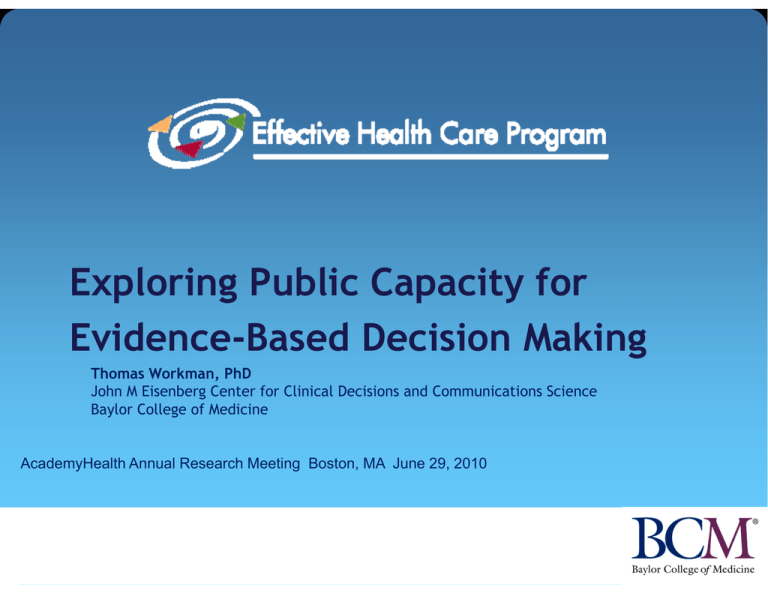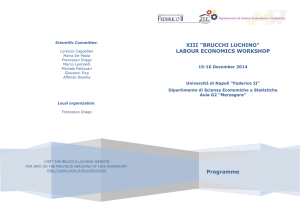Exploring Public Capacity for p g y
advertisement

Exploring p g Public Capacity p y for Evidence-Based Decision Making Thomas Workman, Th W k PhD John M Eisenberg Center for Clinical Decisions and Communications Science Baylor College of Medicine AcademyHealth Annual Research Meeting Boston, MA June 29, 2010 What Is the Effective Health Care Program? What Is the Effective Health Care Program? Section 1013 of the 2003 Medicare Prescription Drug, Improvement, and d Modernization d i i A Act authorized h i d the h A Agency ffor Healthcare Research and Quality (AHRQ) to improve the quality, effectiveness, and efficiency of health care delivered through Medicare, Medicaid, and State Children’s Health Insurance programs. AHRQ started d the h Eff Effective i H Health l hC Care P Program iin 2005 upon appropriation of funds. In 2009, 2009 the American Recovery and Reinvestment Act (ARRA) awarded additional funding to AHRQ to: broaden comparative p effectiveness research,, build an infrastructure to support the expanded efforts, and invest in innovative mechanisms to disseminate findings of research to health care decisionmakers. AHRQ Task Order Officers Develop, coordinate, and monitor Scientific Resource Center coordinates topic selection/peer review/public input, provides support p pp Evidence based Practice Centers Evidence-based Evidence Synthesis and Evidence Need Identification Stakeholders N i t topics, Nominate t i provide input on questions, reviews, and program DEcIDE, CERTs, Grantees Evidence Generation Eisenberg Ei b Center C t Evidence Translation and Dissemination Patients, health care providers, and policymakers make better health care decisions The John M. Eisenberg Center for Clinical Decisions and Communications Science Decisions and Communications Science The nation’s translation and dissemination unit for AHRQ’s Effective Health Care Program Translates and disseminates effectiveness and comparative effectiveness reviews for consumers, clinicians, and policymakers Actionable A i bl summary guides id Continuing medical education units Decision aids Other Products Coordinated with other AHRQ efforts such as Healthcare 411 Key Focus: Adoption of EBDM Practices Key Focus: Adoption of EBDM Practices Clarifying the Concepts Evidence-based Medicine Patient-Centered Medicine Consumer Adoption of EBDM Initial Assessment: Internal and External Considerations for Capacity Building Suggested Next Research Steps Conceptualizing EBM Conceptualizing EBM Evidence-based medicine and patient-centered medicine are distinctly different concepts with research that has not connected the two (Bensing, 2000). 2000) Evidence based medicine is the conscientious, conscientious explicit, and judicious use of current best evidence in making decisions about the care of individual patients. The practice of evidence based medicine means integrating individual clinical expertise with the best available external clinical evidence from systematic research (Sackett, 1996). Conceptualizing Adoption Capacity: PCM Conceptualizing Adoption Capacity: PCM In a patient-centered model, patients become active ti participants ti i t iin th their i own care and d receive i services designed to focus on their individual needs and preferences, preferences in addition to advice and counsel from health professionals (Stanton, 2002). Patient-centered medicine involves multiple p concepts: Shared decision making Patient involvement Health information seeking Health literacyy Patient activation Self-efficacy Patient satisfaction Conceptualizing Adoption Capacity: Adoption p g p p y p Context-based evidence-based decision-making (Dobrow et al., 2004) Focus has been on evidence base and not the d i i decision-making ki context t t Both evidence and context are integral components Internal I l and d externall contextuall factors f must be b considered Internal: Purpose, Purpose process process, participants External: Disease, jurisdiction, politics Dobrow (et. al) Conceptual Framework p Changes to the External Context of EBDM Changes to the External Context of EBDM Formation of the Agency for Healthcare Research and Quality (AHRQ) in 1999 Medicare Modernization Act of 2003 – established AHRQ’s Effective Health Care Program American Recovery and Reinvestment Act of 2009 – established the Federal Coordinating Council for Comparative Effectiveness Research added funds IOM and Federal Coordinating Council publish definitions and national priorities P ti t Protection Patient P t ti and d Aff Affordable d bl Care C A Actt off 2010 -established the Patient-Centered Outcomes Research Institute, added additional research funds EBDM being refocused as patient-centered research USHHS creates new national action plan to improve health literacy in 2010. 2010 Internal Context: What Do We Know? Internal Context: What Do We Know? Most physicians are not engaging patients in the decisionmaking process (Mauksch et et. al al., 2008) Patients rarely initiate conversations or questions during office visits ((Tran,, et. al.,, 2008)) Patient Decision Aids are underutilized (O’Connor, et.al., 2004) 70 % of Patient Non Non-adherence adherence is intentional (Clifford, et.al., 2008) Nearly 9 out of 10 adults have difficulty using everyday health information (Kutner, et. al., 2006) 62% of internet searches are health related (Heese, et. al., 2005) Internal Context: What Do We Know? Internal Context: What Do We Know? DECISIONS study (2010) 82% considered at least one medical decision in the past 2 years Highest Hi h t percentage t iinvolved l d cancer screening i Individuals with a primary care provider considered decisions more often than those who did not. Women made decisions more often then men. men Age, education, and availability of insurance were all inconsistent factors across decision types Internal Context: What Do We Know? Internal Context: What Do We Know? AIR study y ((Carman et. al.,, 2010)) Consumer confusion by terminology of medical evidence Belief that all medical care meets minimum quality standards Belief that medical guidelines are an inflexible, bargain-basement approach Most Patients believe more care, newer care, and more costly care is better Consumers C connecting ti “ “evidence-based id b d medical di l decisions” with political agendas and cost-saving measures that ultimately deny them care Considerations for Capacity Building Considerations for Capacity Building Addressing Internal Contextual Barriers Increase consumer desire and appreciation for comparative evidence Patient Patient-Provider Provider interactions must support evidence evidencebased decisionmaking across conditions Q Qualityy of evidence-based information p products is critical, but product testing may not identify or address broader internal context influences Testing information comprehension versus “process” outcomes Testing decision conclusions in light of contextual influences within the clinical setting Considerations Considerations for Capacity Building for Capacity Building Addressing External Contextual Barriers Evidence-based E id b dd decisions i i mustt reflect fl t actual t l“ “power of choice” across conditions and populations Patient choice-making choice making must be separated from a “Medical consumerism” frame Evidence Evidence-based based decisionmaking must be incentivized across clinicians, consumers, and policymakers. EBDM must be de de-politicized politicized and separated from other issues of health care reform Possible steps for research Possible steps for research Connecting decision science to broader issues of EBDM Determining the impact of literacy, agency, and patient activation on the adoption of EBDM Exploring E l i th the role l off interactive i t ti social i l media di iin th the evidence introduction, interpretation, and application context Time to focus on medical choicemaking representations in popular culture? Developing better assessment tools for EBDM uptake and long-term g outcomes Exploring ways in which translation and dissemination efforts can also build capacity
